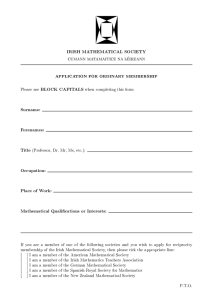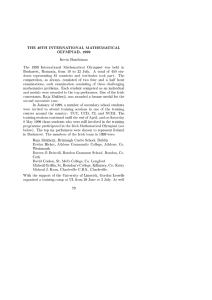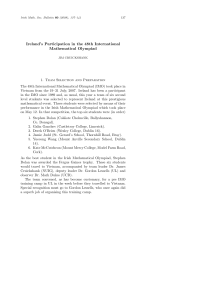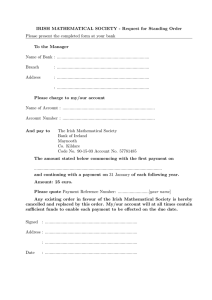Document 11012133
advertisement
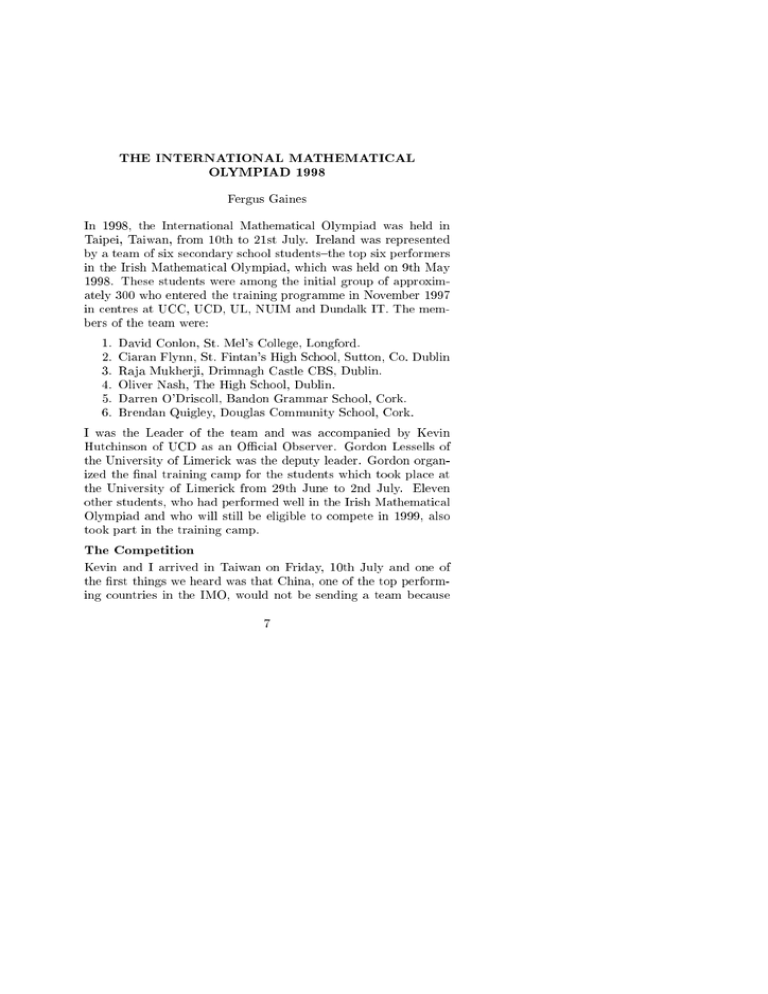
THE INTERNATIONAL MATHEMATICAL
OLYMPIAD 1998
Fergus Gaines
In 1998, the International Mathematial Olympiad was held in
Taipei, Taiwan, from 10th to 21st July. Ireland was represented
by a team of six seondary shool students{the top six performers
in the Irish Mathematial Olympiad, whih was held on 9th May
1998. These students were among the initial group of approximately 300 who entered the training programme in November 1997
in entres at UCC, UCD, UL, NUIM and Dundalk IT. The members of the team were:
1. David Conlon, St. Mel's College, Longford.
2. Ciaran Flynn, St. Fintan's High Shool, Sutton, Co. Dublin
3. Raja Mukherji, Drimnagh Castle CBS, Dublin.
4. Oliver Nash, The High Shool, Dublin.
5. Darren O'Drisoll, Bandon Grammar Shool, Cork.
6. Brendan Quigley, Douglas Community Shool, Cork.
I was the Leader of the team and was aompanied by Kevin
Huthinson of UCD as an OÆial Observer. Gordon Lessells of
the University of Limerik was the deputy leader. Gordon organized the nal training amp for the students whih took plae at
the University of Limerik from 29th June to 2nd July. Eleven
other students, who had performed well in the Irish Mathematial
Olympiad and who will still be eligible to ompete in 1999, also
took part in the training amp.
The Competition
Kevin and I arrived in Taiwan on Friday, 10th July and one of
the rst things we heard was that China, one of the top performing ountries in the IMO, would not be sending a team beause
7
8
IMS Bulletin
41, 1998
the hosts insisted on using the titles \Taiwan" and \Republi of
China" instead of the internationally aepted \China{Taipei".
The team leaders and the observers from all of the partiipating ountries were aommodated in a resort area to the north of
Taipei, well away from the students' aommodation in National
Taiwan Normal University (NTNU). The leaders formed the IMO
jury and their initial task was to selet the six ompetition problems from a list of 28, shortlisted from those submitted by the
partiipating ountries. None of the problems submitted by Ireland made it to the short list. The problems on the short list whih
are not hosen for the IMO remain ondential and may not be
published until one year has elapsed. Sine the jury onsists of
the leaders of all the partiipating ountries, the disussions at
the meetings an get very heated and arimonious and national
rivalries an rear their ugly heads.
After two days of intense disussion, the six problems and
the preise English wording were agreed. The seond day's deliberations had taken 12 hours to omplete but, about ten minutes
after the jury meeting had ended and when a number of people had
already left, Professor Svetoslav Savhev, who was a member of
the organizers' Problem Seletion Committee whih drew up the
shortlist, announed that he had just disovered that one of the
problems seleted was very lose in ontent to a problem that had
already appeared in the Canadian journal Crux Mathematiorum.
After some disussion, it was agreed the problem would have to be
withdrawn, beause IMO problems are supposed to be ompletely
unseen and several leaders pointed out that many of their students
subsribe to Crux. An informal disussion then took plae on how
best to proeed, but it soon degenerated into haos sine everyone
was very tired. However, the next morning, reason prevailed, a
substitute was found for the deleted problem, and the papers and
their translations into all the languages required by the students
were approved by the jury.
The Irish team, aompanied by Gordon Lessells, arrived
in Taipei on 12th July but, sine they were one day early, did
not move into their aommodation in NTNU until the next day.
Beause the weather was very hot and humid, the students stayed
International Mathematial Olympiad, 1998
9
indoors most of the time. This lessened the time available to soialize with students from other ountries{one of the important features of the IMO. The OÆial Opening, whih was performed by
Mr Vinent Siew, the Prime Minister, took plae on 14th July.
The students sat the rst paper on Wednesday, 15th July,
and the seond one the following day. Eah paper lasted 4 21 hours.
After eah exam, Gordon was on hand to talk to our students about
the questions and to give support to those who felt they hadn't
done as well as they expeted. On the morning of eah exam,
Kevin and I travelled with the other leaders to NTNU{a two-hour
journey through Taipei's haoti traÆ jams{to be present in the
jury room to answer queries from ontestants about the papers.
At lunhtime on the day of the seond paper, all leaders,
deputy leaders and observers transferred to the Howard Plaza
Hotel in entral Taipei. The Irish students' answer books were
arefully read by Gordon, Kevin and me and provisional marks
assigned in aordane with the marking sheme supplied by the
Taiwanese oordinators. There was quite a delay in getting the
students' work beause photoopies were made of all the answers
by the loal IMO organization. This was done for two reasons: to
prevent any leader from making additions to the students' work
and to give the oordinators the hane to read eah student's
answers before the oordination sessions. On the Friday and Saturday, we went to the oordinators for eah question to nalize the
marks to be awarded to eah student. A lot of hard work had to
be done in advane of this beause it was important to have very
lear arguments for the marks we thought our students should get.
In one ase, we were more than pleasantly surprised by the generosity of the oordinators. In another ase we had to ght for the
marks{the oordinators were quite taken abak when we indiated
that one of Raja Mukherji's answers should get full marks. They
hadn't understood his argument, but readily gave the marks when
we explained it to them. Coordination went quite quikly, mainly
due to the fat that the oordinators were well-aquainted with
eah student's work before we went to see them.
10
IMS Bulletin
41, 1998
The Results
The high point of the IMO for the Irish team in Taiwan was the
award of a bronze medal to 15-year old Raja Mukherji. Sine Ireland began partiipating in the IMO in 1988, this is only the third
time an Irish student has won a medal{bronze medals were won
by Andrew MMurry in 1990 and Kevin MGerty in 1993. Given
our limited training programme, we do not expet our students to
win medals very often. Raja has been in the training programme
for the last three years and has learned a lot of mathematis in
that time. He already represented Ireland in the IMO in Argentina in 1997 and will still be eligible to take part in the 40th IMO
in Romania in 1999. Eah question in the IMO is marked out
of 7 marks, making a total of 42 for the whole exam. Medals
are awarded to \not more than half the students taking part, at
most 1/12th of the students an win gold, at most 1/6th silver
and at most 1/4 bronze". The ut-o mark for a bronze medal
in Taiwan was 14 points, so Raja's total of 18 points gave him a
omfortable margin. This was the highest sore ever ahieved by
an Irish student in an IMO and, to put it into perspetive, Raja's
sore equalled the sum of the sores of the other ve members of
the Irish team! Sine eah mark awarded represents a substantial
ontribution towards the solution of a problem, marks are very
hard to earn at the IMO. In fat, of the 404 students who took
part, 16 sored zero!
The IMO is a ompetition for individuals, but there is
always an unoÆial ranking of national teams. The top ten teams
this year, in order, were Iran, Bulgaria, Hungary, USA, Republi of China (Taiwan), Russia, Indonesia, Ukraine, Vietnam and
Yugoslavia. This order is probably a reetion of the elaborate
training programmes organized by some ountries. Many ountries have a series of mathematial ompetitions, throughout their
eduational system and, in some ases, their training programmes
rival those for training professional athletes. With our limited
programme, we have ahieved modest suess. This year, the
Irish team ranked 56th of the 74 ompeting ountries.
When not taking part in the ompetition, the students were
taken on several ultural and sight-seeing trips. One trip took
International Mathematial Olympiad, 1998
11
them to a region in the entre of Taiwan, on the very day that
partiular area experiened its worst earthquake for many years!
Although ve people were killed by a ollapsing building our students, who were travelling in their oah at the time, never even
notied the 'quake!
The problems in national Olympiads are always somewhat
easier than those of the IMO. So, for omparison, we give rst
the problems of the 1998 Irish Mathematial Olympiad. The time
allowed for eah paper in the Irish ompetition is three hours,
whereas that in the IMO itself is four and a half hours. Here are
the two Irish papers:
Eleventh Irish Mathematial Olympiad
First Paper
1.
Show that if x is a nonzero real number, then
8
x
4.
5.
1
x
1
+ 4
x
0
:
is a point inside an equilateral triangle suh that the distanes from P to the three verties are 3, 4 and 5, respetively. Find the area of the triangle.
Show that no integer of the form xyxy in base 10 (where x
and y are digits) an be the ube of an integer.
Find the smallest base b > 1 for whih there is a perfet
ube of the form xyxy in base b.
Show that a dis of radius 2 an be overed by seven (possibly overlapping) diss of radius 1.
If x is a real number suh that x2 x is an integer, and, for
some integer n 3, xn x is also an integer, prove that x
is an integer.
2. P
3.
5
x
12
IMS Bulletin
6.
41, 1998
Seond Paper
Find all positive integers n that have exatly 16 positive
integer divisors d1 , d2 , : : : , d16 suh that
1 = d1 < d2 < < d16 = n
6 = 18 and d9
d
7.
8 = 17.
d
Prove that if a, b, are positive real numbers, then
(1)
9
a
+b+
2
1
1
1
+
+
a+b
b+
+a
and
(2)
1
1
1
+
+
a +b
b+
+a
1
2
1
a
+
1
b
+
1
;
:
Let N be the set of natural numbers (i.e., the positive
integers).
(a) Prove that N an be written as a union of three mutually
disjoint sets suh that, if m; n 2 N and jm nj = 2 or 5,
then m and n are in dierent sets.
(b) Prove that N an be written as a union of four mutually
disjoint sets suh that, if m; n 2 N and jm nj = 2; 3 or 5,
then m and n are in dierent sets. Show, however, that it is
impossible to write N as a union of three mutually disjoint
sets with this property.
9. A sequene of real numbers xn is dened reursively as follows: x0 and x1 are arbitrary positive real numbers, and
8.
n+2 =
x
10.
1 + xn+1
x
n
; n
= 0; 1; 2; : : :
Find x1998 .
A triangle ABC has positive integer sides, Ab = 2Bb and
b > 90Æ. Find the minimum length of its perimeter.
C
The questions of the 39th IMO were as follows. We give solutions
to these IMO problems on pp. 72{76.
International Mathematial Olympiad, 1998
13
Thirty Ninth International Mathematial Olympiad
First Day | 15th July 1998
1.
2.
In the onvex quadrilateral ABC D, the diagonals AC and
BD are perpendiular and the opposite sides AB and DC
are not parallel. Suppose that the point P , where the perpendiular bisetors of AB and DC meet, is inside ABC D.
Prove that ABC D is a yli quadrilateral if and only if the
triangles ABP and C DP have equal areas.
In a ompetition, there are a ontestants and b judges, where
b 3 is an odd integer. Eah judge rates eah ontestant
as either \pass" or \fail". Suppose that k is a number suh
that, for any two judges, their ratings oinide for at most
k ontestants. Prove that
k
a
3.
b
2b
1
:
For any positive integer n, let d(n) denote the number of
positive divisors of n (inluding 1 and n itself).
Determine all positive integers k suh that
( 2)
=k
d(n)
d n
for some n.
Seond Day | 16th July 1998
4.
5.
Determine all pairs (a; b) of positive integers suh that ab2 +
2
b + 7 divides a b + a + b
Let I be the inentre of the triangle ABC . Let the inirle
of ABC touh the sides BC , C A and AB at K , L and M ,
respetively. The line through B parallel to M K meets the
lines LM and LK at R and S , respetively. Prove that
6 RI S is aute.
14
IMS Bulletin
6.
41, 1998
Consider all funtions f from the set N of all positive integers
into itself satisfying
( 2 ( )) = s(f (t))2 ;
f t f s
for all s and t in N . Determine the least possible value of
f (1998).
Fergus Gaines
Department of Mathematis
University College Dublin
Beleld
Dublin 4

